Sony FST-ZX100D, FST-ZX80D, LBT-ZX80D, LBT-ZX100D User Manual
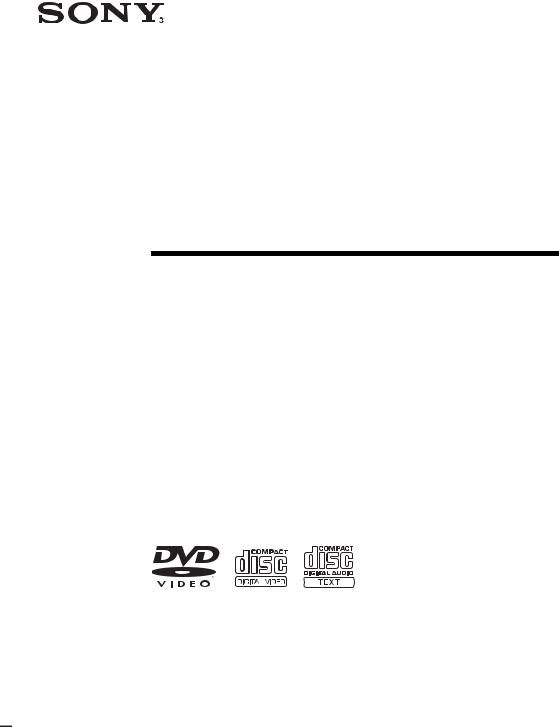
2-672-108-12(2)
Mini Hi-Fi
Component
System
Operating Instructions
FST-ZX100D/ZX80D
LBT-ZX100D/ZX80D
MHC-GN1000D
©2006 Sony Corporation
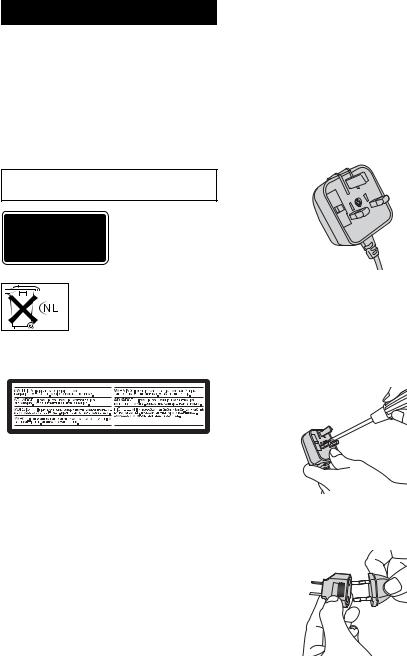
WARNING
To reduce the risk of fire or electric shock, do not expose this apparatus to rain or moisture.
To prevent fire, do not cover the ventilation of the apparatus with newspapers, table-cloths, curtains, etc. And don’t place lighted candles on the apparatus.
To prevent fire or shock hazard, do not place objects filled with liquids, such as vases, on the apparatus. To avoid electrical shock, do not open the cabinet. Refer servicing to qualified personnel only.
Do not install the appliance in a confined space, such as a bookcase or built-in cabinet.
This appliance is classified as a CLASS 1 LASER product. This label is located on the rear exterior.
Don’t throw away the battery with general house waste, dispose of it correctly as chemical waste.
The following caution label is located inside the apparatus.
Note on power cord plug shapes (Saudi Arabian model only)
For AC 220 V wall sockets
1Make the appropriate voltage setting on the system (only for models with a voltage selector).
2Make sure that the 13 A 3-pin plug (Type BF) is securely attached to the power cord. (The 13 A 3-pin plug is attached when shipped from the factory.)
For AC 127 V wall sockets
1Make the appropriate voltage setting on the system (only for models with a voltage selector).
2Remove the 13 A 3-pin plug using a screwdriver.
3Attach the supplied parallel blade plug (Type A).
2GB

Table of Contents |
|
About this manual ................................... |
5 |
Playable discs.......................................... |
6 |
Getting Started |
|
Hooking up the system............................ |
9 |
Positioning the speakers........................ |
13 |
Setting the clock.................................... |
14 |
Performing QUICK SETUP ................. |
14 |
Using the THEATRE SYNC function .. |
15 |
Changing the format of the video signal |
|
from COMPONENT VIDEO OUT |
|
jacks ................................................ |
16 |
Disc – Playback |
|
Loading a disc ....................................... |
18 |
Playing a disc ........................................ |
18 |
— Normal Play |
|
Resuming playback from the point you |
|
stopped the disc .............................. |
21 |
— Resume Play |
|
Creating your own program .................. |
21 |
— Program Play |
|
Playing in random order........................ |
23 |
— Shuffle Play |
|
Playing repeatedly................................. |
24 |
— Repeat Play |
|
Playing DVD VIDEOs using the |
|
menu ............................................... |
25 |
Selecting “ORIGINAL” or |
|
“PLAY LIST” on a DVD-R/ |
|
DVD-RW in VR mode ................... |
25 |
Playing VIDEO CDs with PBC |
|
functions (Version 2.0) ................... |
26 |
— PBC Playback |
|
About MP3 audio tracks and |
|
JPEG image files ............................ |
26 |
Playing DATA CDs or DATA DVDs |
|
with MP3 audio tracks and |
|
JPEG image files ............................ |
28 |
Playing MP3 audio tracks and JPEG |
|
image files as a slide show with |
|
sound............................................... |
30 |
Enjoying DivX® video files.................. |
32 |
Using the on-screen display to search |
|
for a title/chapter/scene/track/ |
|
index/album/file ............................. |
34 |
Searching by scene ............................... |
36 |
— Picture Navigation |
|
Disc – Various Functions |
|
Selecting the audio format .................... |
37 |
Changing the angles.............................. |
38 |
Displaying the subtitles ........................ |
38 |
Adjusting the delay between the |
|
picture and sound ........................... |
39 |
— A/V SYNC |
|
Restricting playback of the disc............ |
39 |
— CUSTOM PARENTAL |
|
CONTROL, PARENTAL |
|
CONTROL |
|
Using the DVD setup menu.................. |
43 |
Tuner |
|
Presetting radio stations........................ |
51 |
Listening to the radio............................ |
53 |
Tape – Playback |
|
Loading a tape ...................................... |
54 |
Playing a tape........................................ |
54 |
Tape – Recording |
|
Recording your favorite disc onto a |
|
tape ................................................. |
55 |
— CD Synchro Recording |
|
Recording onto a tape manually ........... |
55 |
— Manual Recording |
|
continued
3GB

Sound Adjustment |
|
Adjusting the sound .............................. |
56 |
Selecting the preset effect ..................... |
57 |
Adjusting the graphic equalizer and |
|
storing the user equalizer setting .... |
57 |
Selecting the sound field ....................... |
57 |
Using the subwoofer ............................. |
59 |
(FST-ZX100D/LBT-ZX100D/ |
|
MHC-GN1000D only) |
|
Creating a party environment................ |
59 |
— X-TRANCE/X-TRANCE PRO |
|
Listening to the sound in another |
|
room................................................ |
62 |
— Multi Room |
|
(FST-ZX100D/LBT-ZX100D/ |
|
FST-ZX80D/LBT-ZX80D only) |
|
Singing along: Karaoke......................... |
62 |
Mixing and recording sounds................ |
68 |
Timer |
|
Falling asleep to music.......................... |
69 |
— Sleep Timer |
|
Waking up to music .............................. |
69 |
— Play Timer |
|
Timer recording radio programs ........... |
70 |
Display |
|
Turning off the display.......................... |
71 |
— Power Saving Mode |
|
Changing the spectrum analyzer |
|
display............................................. |
72 |
Adjusting the brightness of the |
|
front panel display .......................... |
72 |
Changing the power illuminator ........... |
72 |
Viewing information about the disc |
|
in the front panel display ................ |
73 |
Viewing information about the disc |
|
in the on-screen display .................. |
74 |
Checking the date information of |
|
JPEG image files ............................ |
75 |
Optional Components |
|
Hooking up optional components......... |
76 |
Listening to audio from a connected |
|
component ...................................... |
78 |
Recording audio signal from a |
|
connected component ..................... |
78 |
Recording audio signal on a connected |
|
component ...................................... |
78 |
Troubleshooting |
|
Problems and remedies......................... |
79 |
Self-diagnosis Function ........................ |
85 |
Messages............................................... |
85 |
Additional Information |
|
Precautions ........................................... |
86 |
Specifications ....................................... |
88 |
Guide to the Control Menu display ...... |
92 |
DVD setup menu item list .................... |
95 |
Language code list ................................ |
97 |
Glossary ................................................ |
98 |
List of button locations and reference |
|
pages............................................. |
102 |
4GB
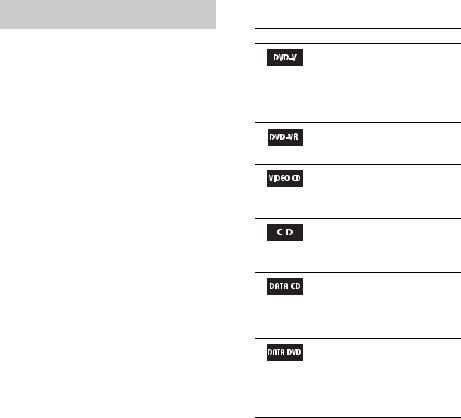
About this manual
•The instructions in this manual are for models FST-ZX100D, LBT-ZX100D, FST-ZX80D, LBT-ZX80D and MHC-GN1000D. In this manual, the LBT-ZX100D is used for illustration purposes unless stated otherwise.
The FST-ZX100D/LBT-ZX100D consists of:
–Tuner/DVD player/Stereo cassette deck/Amplifier (unit)
|
|
HCD-ZX100D |
– Speaker System |
|
|
• |
Front speakers |
SS-ZX100D |
• |
Surround speakers |
SS-ZX100D |
• |
Center speaker |
SS-CT100D |
• |
Subwoofer |
SS-WGV100D |
The FST-ZX80D/LBT-ZX80D consists of:
–Tuner/DVD player/Stereo cassette deck/Amplifier (unit)
|
|
HCD-ZX80D |
– Speaker System |
|
|
• |
Front speakers |
SS-ZX100D |
• |
Surround speakers |
SS-ZX100D |
• |
Center speaker |
SS-CT100D |
The MHC-GN1000D consists of:
–Tuner/DVD player/Stereo cassette deck/Amplifier (unit)
HCD-GN1000D
–Speaker System
•Front speakers
Latin American models
|
|
SS-GN1000D |
|
Other models |
SS-GN1000S |
• |
Surround speakers |
SS-RSX1000D |
• |
Center speaker |
SS-CT1000D |
• |
Subwoofer |
SS-WGV1000D |
•This instructions in this manual describe the controls on the remote. You can also use the controls on the unit if they have the same or similar names as those on the remote.
•The English on-screen display is used for illustration purposes only.
•The Control Menu items may be different depending on the disc.
•The Setup Menu items may be different depending on the area.
•The following symbols are used in this manual.
Symbol Meaning
Functions available for DVD VIDEOs (including DVD-Rs/ DVD-RWs/DVD+Rs/ DVD+RWs in DVD VIDEO format and DVD-Rs/DVD-RWs in video mode).
Functions available for DVD-Rs/
DVD-RWs in VR (Video
Recording) mode.
Functions available for VIDEO CDs (including Super VCDs and CD-Rs/CD-RWs in VIDEO CD or Super VCD format).
Functions available for AUDIO CDs (including CD-Rs/CD-RWs in AUDIO CD format and discs containing CD Graphics1)).
Functions available for DATA CDs (CD-ROMs/CD-Rs/ CD-RWs) containing MP32)
audio tracks, JPEG image files or DivX3)4) video files.
Functions available for DATA DVDs (DVD-ROMs/DVD-Rs/ DVD-RWs/DVD+Rs/ DVD+RWs) containing MP32)
audio tracks, JPEG image files or DivX3)4) video files.
1)Latin American models only.
2)MP3 (MPEG 1 Audio Layer 3) is a standard format defined by ISO/MPEG which compresses audio data.
3)DivX® is a video file compression technology, developed by DivX, Inc.
4)DivX, DivX Certified, and associated logos are trademarks of DivX, Inc. and are used under license.
5GB
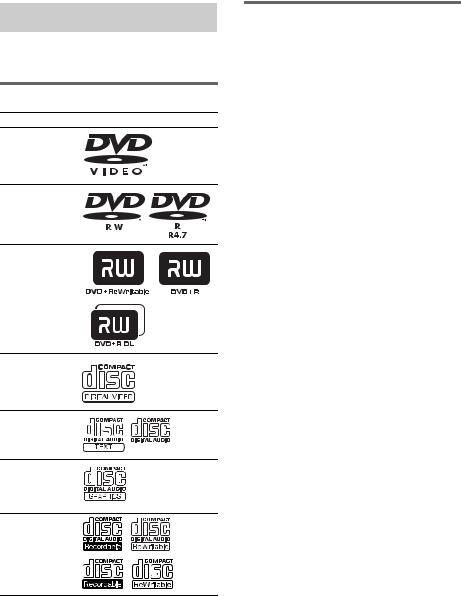
Playable discs
You can play back the following discs on this system. Other discs cannot be played back.
List of playable discs
Format of discs Disc logo
DVD VIDEO
DVD-RW/DVD-R
DVD+RW/
DVD+R
VIDEO CD
AUDIO CD
CD Graphics (CDG)
(Latin American models only)
CD-R/CD-RW
“DVD+RW”, “DVD-RW”, “DVD+R”, “DVD VIDEO”, and the “CD” logos are trademarks.
Notes on discs
The system can play back the following disc:
•CD-ROMs/CD-Rs/CD-RWs recorded in the following formats:
–VIDEO CD format
–AUDIO CD format
–CD Graphics (Latin American models only)
–DATA CD format which contains MP3 audio tracks1), JPEG image files and DivX video files2) of format conforming to ISO 96603) Level 1, Level 2 or Joliet in
expansion format
•DVD-ROMs/DVD-Rs/DVD-RWs/DVD+Rs/ DVD+RWs recorded in the following formats:
–DVD VIDEO format
–DATA DVD format which contains MP3 audio tracks1), JPEG image files and DivX video files2) of format conforming to UDF
(Universal Disk Format)
–VR (Video Recording) format (DVD-Rs/ DVD-RWs only)
The system cannot play back the following discs:
•CD-ROMs recorded in PHOTO CD format
•Data part of CD-Extras4)
•Data part of Mixed CDs5)
•Super Audio CDs
•DVD Audio discs
•DVD-RAMs
•A DVD VIDEO with a different region code.
•A disc that has a non-standard shape (e.g., heart, square, star).
•A disc that has the adhesive cellophane tape or a sticker still left on it.
1)MP3 audio tracks must be in MPEG 1 Audio Layer 3 format.
2)DivX video files must be recorded in DivX format with the extension “.AVI” or “.DIVX”.
3)ISO 9660 Format
A logical format of files and folders on CD-ROMs, defined by ISO (International Organization for Standardization).
6GB
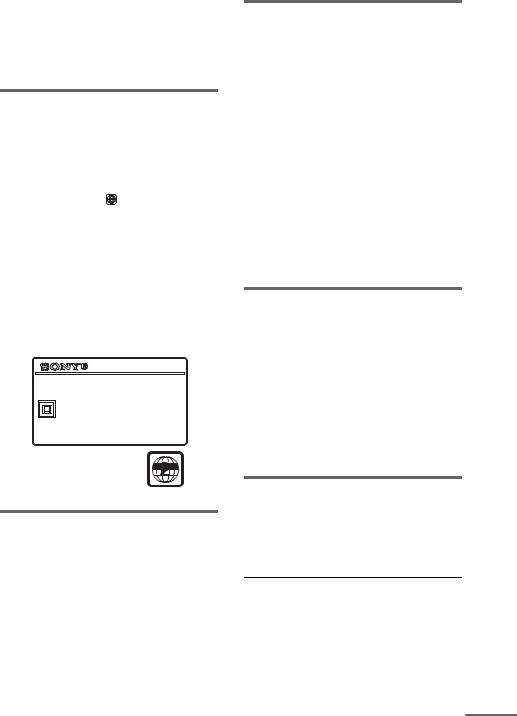
4)CD-Extra: This format records audio (AUDIO CD data) on the tracks in session 1 and data on the tracks in session 2.
5)Mixed CD: This format records data on the first track and audio (AUDIO CD data) on the second and subsequent tracks of a session.
Region code of DVD VIDEOs you can play back on this system
Your system has a region code printed on the back of the unit and will only play back DVD VIDEOs labeled with identical region code.
DVD VIDEOs labeled ALL will also be played back on this system.
If you try to play back any other region code DVD VIDEO, the message “Playback prohibited by area limitations.” will appear on the TV screen. Depending on the DVD VIDEO, no region code indication may be labeled even though playing the DVD VIDEO is prohibited by area restrictions.
Example:
MODEL N0.HCD-ZX100D
DVD DECK RECEIVER
AC:120-127/220/230-240V  50/60Hz 430W
50/60Hz 430W
SERIAL NO.
Region code 



Note on DualDiscs
A DualDisc is a two sided disc product which mates DVD recorded material on one side with digital audio material on the other side. However, since the audio material side does not conform to Compact Disc (CD) standard, playback on this product is not guaranteed.
Notes on CD-R/CD-RW/DVD-R/ DVD-RW/DVD+R/DVD+RW
•In some cases, CD-Rs/CD-RWs/DVD-Rs/ DVD-RWs/DVD+Rs/DVD+RWs cannot be played back on this system due to the recording quality or physical condition of the disc, or the characteristics of the recording device and authoring software. The disc will not be played back if it has not been correctly finalized. For more information, see the operation instructions for the recording device.
•Note that some playback functions may not work with some DVD+RWs/DVD+Rs, even if they have been correctly finalized. In this case, view the disc by normal playback.
•A disc created in Packet Write format cannot be played back.
Note on playback operations of DVD VIDEOs and VIDEO CDs
Some playback operations of DVD VIDEOs and VIDEO CDs may be intentionally set by software producers. Since this system play back DVD VIDEOs and VIDEO CDs according to the disc contents the software producers designed, some playback features may not be available. Also, refer to the instructions supplied with the DVD VIDEOs or VIDEO CDs.
Note on PBC (Playback Control) (VIDEO CDs)
This system conforms to Ver. 1.1 and Ver. 2.0 of VIDEO CD standards. You can enjoy two kinds of playback depending on the disc type.
Disc type |
You can |
VIDEO CDs |
Enjoy video playback (moving |
without PBC |
pictures) as well as music. |
functions |
|
(Ver. 1.1 discs) |
|
|
|
continued
7GB

Disc type |
You can |
VIDEO CDs |
Play back interactive software |
with PBC |
using menu screens displayed on |
functions |
the TV screen (PBC Playback), in |
(Ver. 2.0 discs) |
addition to the video playback |
|
functions of Ver. 1.1 discs. |
|
Moreover, you can play back high- |
|
resolution still pictures, if they are |
|
included on the disc. |
|
|
|
|
Music discs encoded with copyright protection technologies
This product is designed to play back discs that conform to the Compact Disc (CD) standard. Recently, various music discs encoded with copyright protection technologies are marketed by some record companies. Please be aware that among those discs, there are some that do not conform to the CD standard and may not be playable by this product.
Notes on Multi Session disc
•This system can play back Multi Session discs when an MP3 audio track is contained in the first session. Any subsequent MP3 audio tracks recorded in later sessions can also be played back.
•This system can play back Multi Session discs when a JPEG image file is contained in the first session. Any subsequent JPEG image files recorded in later sessions can also be played back.
•If the first session is recorded in AUDIO CD or VIDEO CD format, only the first session will be played back.
•The system will recognize a Multi Session disc as an AUDIO CD if there is a session recorded in AUDIO CD format on the disc. However, the system will only play back the disc if the first session is recorded in AUDIO CD format.
•With DATA CD or DATA DVD, the system will only play back DivX video files even if it contains MP3 audio tracks or JPEG image files.
Copyrights
This product incorporates copyright protection technology that is protected by U.S. patents and other intellectual property rights. Use of this copyright protection technology must be authorized by Macrovision, and is intended for home and other limited viewing uses only unless otherwise authorized by Macrovision. Reverse engineering or disassembly is prohibited.
This system incorporates Dolby* Digital, Dolby Pro Logic (II) adaptive matrix surround decoder, and the DTS** Digital Surround System.
*Manufactured under license from Dolby Laboratories.
“Dolby”, “Pro Logic”, and the double-D symbol are trademarks of Dolby Laboratories.
**Manufactured under license from Digital Theater Systems, Inc.
“DTS” and “ DTS Digital Surround” are registered trademarks of Digital Theater Systems, Inc.
8GB
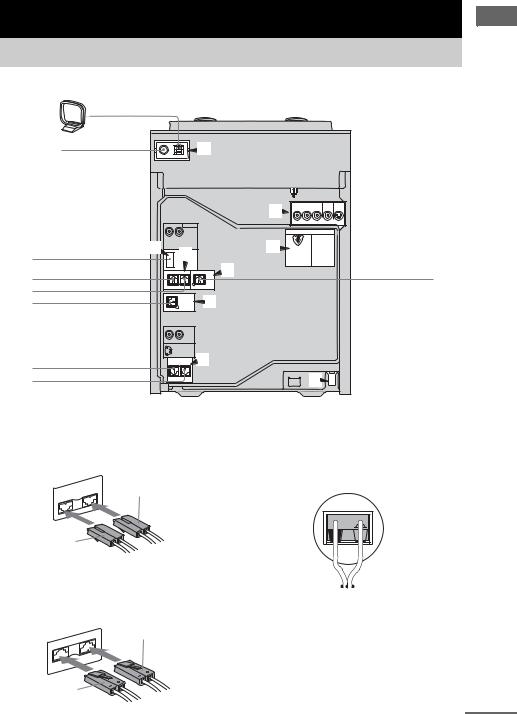
Getting Started
Hooking up the system
Do the following procedures 1to 9to hook up your system using the supplied cords and accessories.
AM loop antenna |
|
|
|
FM lead antenna |
|
6 |
|
|
|
|
|
|
|
|
5 |
To subwoofer |
4 2 |
|
7 |
To surround speaker (right) |
|
3 |
To center speaker |
To surround speaker (left) |
|
|
|
To subwoofer |
|
4 |
|
|
|
|
|
To front speaker (right) |
|
1 |
|
To front speaker (left) |
|
|
8 |
|
|
|
|
1Connect the front speakers.
Connect the speaker cords of the front speakers to the FRONT SPEAKER terminals as shown below.
FRONT |
SPEAKER |
White |
L |
||
R |
|
|
Red
2Connect the surround speakers.
Connect the speaker cords of the surround speakers to the SURR SPEAKER terminals as shown below.
Blue
SPEAKER
SURR
L
R
Tip
FST-ZX100D/LBT-ZX100D/FST-ZX80D/ LBT-ZX80D only
Connect the speaker cords of the front and surround speakers to the terminals on the speakers.
Black (#) 




 Red (3)
Red (3)
Black (#) 
 Red1)/Blue2) (3)
Red1)/Blue2) (3)
1)Front speakers only.
2)Surround speakers only.
Grey
Started Getting
continued
9GB
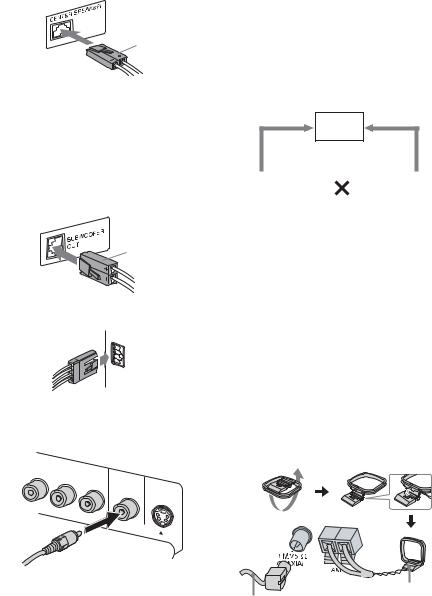
3Connect the center speaker.
Connect the speaker cord of the center speaker to the CENTER SPEAKER terminal as shown below.
Green
4Connect the subwoofer. (FST-ZX100D/LBT-ZX100D/ MHC-GN1000D only)
Connect the subwoofer cord to the SUBWOOFER OUT terminal and the system cord to the SYSTEM CONTROL jack as shown below.
SUBWOOFER OUT terminal
Purple
SYSTEM CONTROL jack
SYSTEM
CONTROL
5Connect the video input jack of your TV to the VIDEO OUT jack with the supplied video cord.
Y |
COMPONENT |
|
|
|
|
VIDEO |
|
VIDEO |
|
|
|
|
OUT |
|
S |
|
|
|
PB/CB |
PR/CR |
OUT |
VIDEO |
|
|
|
|
|
|
OUT |
When using a TV
Turn on the TV and select the video input so that you can view the pictures from this system.
When connecting a video deck
Connect the video deck to the TV using a video cord (not supplied). However, do not connect this unit to the TV through the video deck. Otherwise, you may experience video leakage when watching video images from this system. Connect this unit directly to the TV as shown below.
TV
Video deck |
|
|
|
Unit |
|
|
|
||
|
|
|
|
|
Do not connect directly
Tip
For higher quality video images:
–Use the optional component video cords to connect the COMPONENT VIDEO input jacks on your TV to the COMPONENT VIDEO OUT jacks of this unit. If your TV is compatible with progressive format file signals, use this connection and press PROGRESSIVE on the unit repeatedly until
“P AUTO” or “P VIDEO” appears in the display (page 16).
–You can use an optional S Video cord to connect the S VIDEO input jack on your TV to the S VIDEO OUT jack of this unit.
6Connect the FM and AM antennas.
Set up the AM loop antenna, then connect it.
AM loop antenna
Extend the FM lead antenna horizontally
10GB
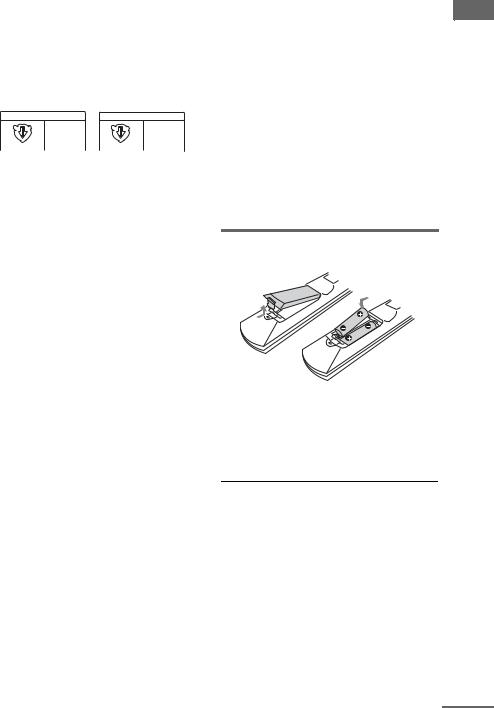
7For models equipped with a voltage selector, set VOLTAGE SELECTOR to the position of your local power line voltage.
Depending on the model, the VOLTAGE SELECTOR may differ.
Brazilian model |
|
only |
Other models |
VOLTAGE SELECTOR |
VOLTAGE SELECTOR |
220V 127V |
220V 120V* |
220V |
230-240V |
* Saudi Arabian model : 120 - 127V
8Connect the power cord to a wall outlet.
The demonstration appears in the display. When you press ?/1, the system turns on and the demonstration automatically ends. If the supplied adaptor on the plug does not fit your wall outlet, detach it from the plug (only for models equipped with an adaptor). For Saudi Arabian model, see “Note on power cord plug shapes” on page 2.
9(Except for Latin American and Russian models)
Set the color system to PAL or NTSC depending on the color system of your TV.
The default setting for color system is different depending on the area.
Each time you perform the procedure below, the color system changes as follows: NTSC y PAL
Use the buttons on the unit for the operation.
1 Press ?/1 to turn off the system.
2 Press ?/1 while holding down X.
The system turns on automatically and the color system is changed. “COLOR NTSC” or “COLOR PAL” appears in the display.
Notes
•Keep the speaker cords away from the antennas to prevent noise.
•Be sure to match the color of the speaker terminals on the unit and the connectors.
•Be sure to connect the speakers securely and correctly. When connecting speaker cords, insert the connector straight into the terminals.
•You cannot set the color system in the Power Saving Mode (see “Turning off the display” on page 71).
•When you play back a VIDEO CD recorded in a different color system from the one you set to the system, the picture image may be distorted.
To connect optional components
See “Hooking up optional components” on page 76.
Inserting two R6 (size AA) batteries into the remote
Operating a Sony TV
You can use the following buttons to operate a Sony TV. These buttons have been marked in orange. To use these buttons, hold down TV before pressing the button you want.
To |
Hold down TV and |
|
press |
|
|
Turn the TV on or off |
TV ?/1 |
|
|
Switch the TV’s input |
TV/VIDEO |
source between the TV |
|
and other input sources |
|
|
|
Select the TV channels |
TV CH +/– or numeric |
|
buttons* |
|
|
Adjust the volume of the |
TV VOL +/– |
TV speaker(s) |
|
|
|
*For double digit number, hold down TV and press -/--, then press the number. (For example, hold down TV, press -/--, then 2 and 5 for entering 25.)
continued
Started Getting
11GB
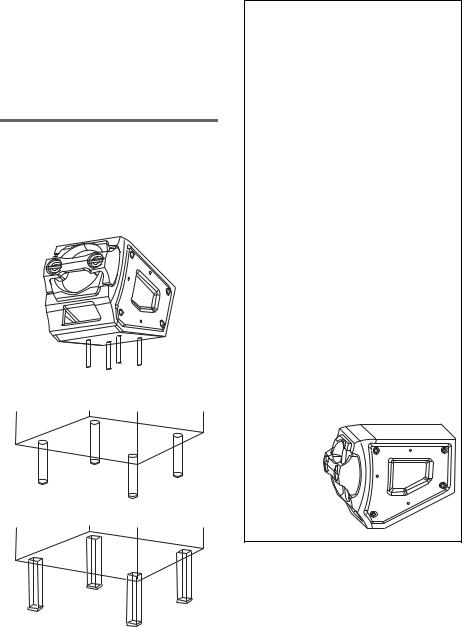
Note
If you do not use the remote for a long period of time, remove the batteries to avoid possible damage from battery leakage and corrosion.
Tip
With normal use, the batteries should last for about six months. When the remote no longer operates the system, replace both batteries with new ones.
Attaching the speaker pads
Attach the supplied speaker pads to the bottom of the speakers to stabilize the speakers and to prevent them from slipping.
Example
Front/surround speaker of FST-ZX100D
Front speaker of MHC-GN1000D
Subwoofer of FST-ZX100D
When carrying the unit
Do the following procedure to protect the disc mechanism.
Use the buttons on the unit for the operation.
1Press ?/1 to turn on the system.
2Press DVD.
3Press Z OPEN/CLOSE to open the disc tray and remove the disc. If there are more than one disc in the disc tray, press EX-CHANGE/DISC SKIP to remove the discs.
4Press Z OPEN/CLOSE again to close the disc tray. Wait until “DVD No Disc” appears in the display.
5Hold down DVD and then press ?/1 until “STANDBY” appears in the display. Then, “MECHA LOCK” appears in the display.
6Unplug the AC power cord.
When carrying the front and surround speakers
(FST-ZX100D/LBT-ZX100D/FST-ZX80D/ LBT-ZX80D only)
Do not carry the front and surround speakers by their sub panel. Otherwise, the speakers may be damaged.
Sub panel 
12GB
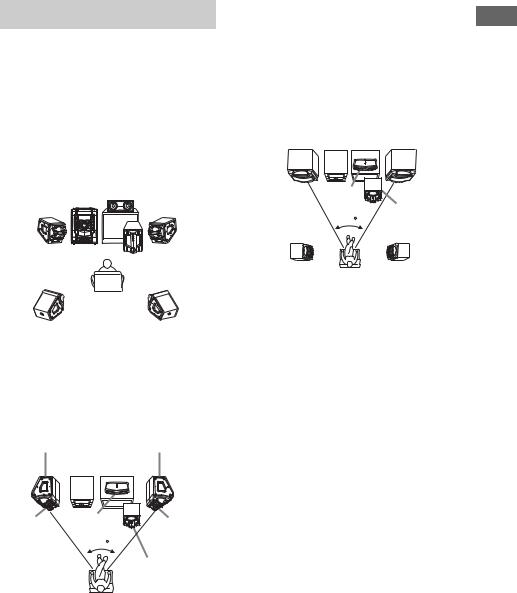
Positioning the speakers
FST-ZX100D/LBT-ZX100D/FST-ZX80D/ LBT-ZX80D only
There are 3 different ways to place the speakers. To enjoy DVD VIDEOs or to create a party environment, we recommend that you place your speakers as shown in Example 1.
Example 1
Place the speakers at an equal distance from your listening position as shown below.
|
Center |
|
|
speaker |
|
|
Unit |
|
Front |
TV |
Front |
|
||
speaker |
|
speaker |
(left) |
|
(right) |
|
Sub woofer* |
|
|
Listener |
|
Surround |
Surround |
|
speaker (left) |
speaker (right) |
|
* Not supplied for FST-ZX80D/LBT-ZX80D
Example 2
Place the surround speakers on top of the front speakers as shown below.
Surround |
|
Surround |
|
speaker (left) |
|
speaker (right) |
|
|
Unit |
TV |
|
Front speaker |
Center |
Front speaker |
|
speaker |
|||
(left) |
(right) |
||
|
|||
|
45 |
|
|
|
|
Sub woofer* |
Listener
* Not supplied for FST-ZX80D/LBT-ZX80D
Example 3
Place the front speakers in one room and the surround speakers in another room. For details, see “Listening to the sound in another room” on page 62.
MHC-GN1000D only
Place the front speakers at an angle of 45 degrees from your listening position.
Unit |
TV |
Front |
Front |
speaker |
speaker |
(left) |
(right) |
|
Center |
|
speaker |
|
Sub woofer |
|
45 |
Surround |
Surround |
speaker |
speaker |
(left) |
(right) |
|
Listener |
Notes
•Do not place the surround speakers on top of a TV. This may cause distortion of the colors in the TV screen.
•If you place the center speaker on the unit, be sure to place it at the front side of the unit.
•Place the subwoofer on solid floor where resonance is unlikely to occur so that a better bass reproduction could be obtained.
•Always place the subwoofer vertically, keeping it a few centimeters away from the wall.
•If the subwoofer is placed in the center of a room, the bass could be extremely weakened. This is due to the influence of the standing wave of the room. If this happens, move the subwoofer away from the center of the room or eliminate the cause of the standing wave, by placing a bookshelf against the wall, etc.
Speaker settings
To enjoy DVD VIDEOs and other discs with multi-channel sound and Dolby surround effects, you need to adjust the speaker settings. For details, see “Setting the speakers” on page 47.
Started Getting
13GB
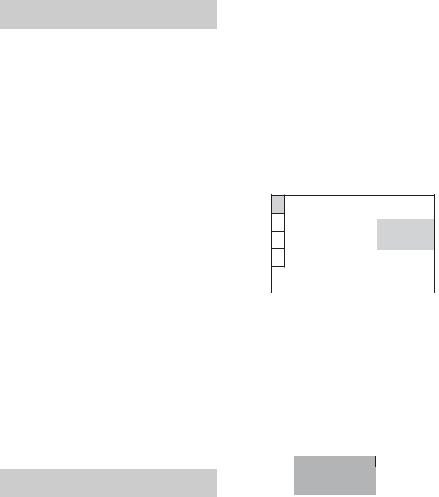
Setting the clock
1 Press ?/1 to turn on the system.
2 Press TIMER MENU.
The hour indication flashes in the display.
3 Press V or v repeatedly to set the hour.
4 Press ENTER.
The minute indication flashes in the display.
5 Press V or v repeatedly to set the minute.
6 Press ENTER.
The clock starts functioning.
To adjust the clock
1Press TIMER MENU.
“PLAY SET?” flashes in the display.
2Press V or v repeatedly to select “CLOCK SET?”, then press ENTER.
The hour indication flashes in the display.
3Do the same procedures as step 3 to 6 above.
Notes
•The clock settings are canceled when you disconnect the power cord or if a power failure occurs.
•You cannot set the clock in Power Saving Mode (page 71).
Performing QUICK SETUP
Before using the system, you can make the minimum basic adjustments (LANGUAGE SETUP, SCREEN SETUP, SPEAKER SETUP) in QUICK SETUP. After performing QUICK SETUP, the system is ready for playback. To perform further speakers settings, see “Setting the speakers” on page 47.
1 Turn on your TV and select the video input.
2 Press ?/1 to turn on the system.
Note
Make sure that the headphone or microphone is not connected. Otherwise, you cannot perform SPEAKER SETUP.
3 Press FUNCTION +/– repeatedly to select “DVD” (or press DVD on the unit).
The guide message appears at the bottom of the TV screen.
4 Press ENTER.
The “LANGUAGE SETUP” display appears on the TV screen.
LANGUAGE SETUP
|
|
OSD: |
ENGLISH |
|
|
MENU: |
ENGLISH |
|
|
AUDIO: |
FRENCH |
|
|
SUBTITLE: |
SPANISH |
|
|
|
PORTUGUESE |
|
|
|
|
5 Press V or v repeatedly to select a language, then press ENTER.
Tips
•The selected language is for “OSD”, “MENU” and “SUBTITLE ”.
•The selectable language is different depending on the area.
The setting is selected and the “SCREEN SETUP” display appears on the TV screen.
|
SCREEN SETUP |
|
|
|
|
|
TV TYPE: |
|
16:9 |
|
|
COLOR SYSTEM (VIDEO CD): |
16:9 |
|
|
|
SCREEN SAVER: |
4:3 LETTER BOX |
|
|
|
BACKGROUND: |
4:3 PAN SCAN |
|
|
|
4:3 OUTPUT: |
|
FULL |
|
|
|
||
|
|
|
|
|
|
|
|
|
|
6 Press V or v repeatedly to select the setting that matches your TV type.
xIf you have a 4:3 standard TV
Select 4:3 LETTER BOX or 4:3 PAN SCAN (page 45)
xIf you have a wide-screen TV or a 4:3 standard TV with wide-screen mode
Select 16:9 (page 45)
14GB
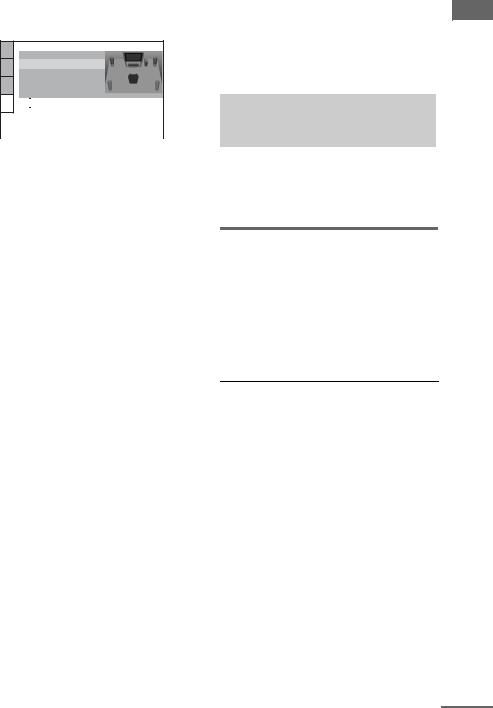
7 Press ENTER.
The setting is selected and the “SPEAKER SETUP” display appears on the TV screen.
SPEAKER SETUP
SIZE:
DISTANCE:
LEVEL(FRONT):
LEVEL(SURROUND):
|
TEST TONE: |
OFF |
||
|
|
FRONT: |
|
* 3.0m |
|
|
CENTER: |
|
3.0m |
|
||||
|
|
SURROUND: |
|
3.0m |
8 Press V or v repeatedly to select the front speaker distance from your listening position, then press ENTER.
You can set from 1.0 to 7.0 meters. Repeat this step to adjust the center and surround speaker distance. For the center and surround speaker distance, you can set from 0.0 to 7.0 meters.
The setting is selected and “QUICK SETUP is complete.” appears on the TV screen.
To quit QUICK SETUP
Press  DISPLAY.
DISPLAY.
To change the settings of QUICK SETUP
1Press  DISPLAY when playback is stopped.
DISPLAY when playback is stopped.
The Control Menu appears on the TV screen.
2Press V or v repeatedly to select  (SETUP), then press ENTER.
(SETUP), then press ENTER.
3Press V or v repeatedly to select “QUICK”, then press ENTER.
The “LANGUAGE SETUP” display appears on the TV screen.
4Do the same procedures as steps 5 to 8 of “Performing QUICK SETUP”.
Notes
•The guide message appears at the bottom of the TV screen when you turn on the system
for the first time or after performing “RESET” (see “To return the DVD setup to the default settings*, perform reset as follows:” on page 84).
•If you do not want to perform QUICK SETUP, press CLEAR in step 3. The guide message will disappear from the TV screen.
•When there is a disc in the unit or the disc tray is opened, the guide message does not appear on the TV screen. To perform QUICK SETUP, press Z OPEN/ CLOSE on the unit to remove the disc and press again to close the disc tray.
•If you want to change each setting individually, see “Using the DVD setup menu” on page 43.
Using the THEATRE SYNC function
THEATRE SYNC allows you to turn on your Sony TV and this system, changes the system’s function to “DVD” and then switches the TV’s input source you have set with just one button.
Preparing for the THEATRE SYNC function
Register the TV’s input source connected to this system.
Hold down SLEEP and press numeric buttons, CLEAR or ALBUM +/– to select the TV’s input source connected to this system.
For details, refer to the following table.
Hold down SLEEP |
To select the following |
and press |
TV’s input source |
|
|
0 |
No input source |
|
(Default) |
|
|
1 |
VIDEO 1 |
|
|
2 |
VIDEO 2 |
|
|
3 |
VIDEO 3 |
|
|
4 |
VIDEO 4 |
|
|
5 |
VIDEO 5 |
|
|
6 |
VIDEO 6 |
|
|
7 |
VIDEO 7 |
|
|
8 |
VIDEO 8 |
|
|
9 |
COMPONENT 1 |
|
|
CLEAR |
COMPONENT 2 |
|
|
ALBUM – |
COMPONENT 3 |
|
|
ALBUM + |
COMPONENT 4 |
|
|
The selected TV’s input source is memorized into the remote.
continued
Started Getting
15GB

Operating the THEATRE SYNC function
Point the remote to the direction of the TV and this unit, then press THEATRE SYNC.
If this function does not work, change the transmission time. The transmission time varies depending on the TV.
To change the transmission time
Hold down > and press numeric buttons to change the transmission time.
For details, refer to the following table.
Hold down > |
To select the following |
and press |
transmission time |
|
|
1 |
0.5 (Default) |
|
|
2 |
1 |
|
|
3 |
1.5 |
|
|
4 |
2 |
|
|
5 |
2.5 |
|
|
6 |
3 |
|
|
7 |
3.5 |
|
|
8 |
4 |
|
|
The transmission time from the remote is selected.
Notes
•This function is only available for Sony TV series.
•If distance between the TV and this unit is too far, this function may not work. Install the unit near the TV.
•Keep the remote pointed in the direction of the TV until the TV is turned on and the input source is changed correctly.
Changing the format of the video signal from COMPONENT VIDEO OUT jacks
Progressive is the method for displaying the TV images which reduces flickering and sharpens the image. To use this method, you need to connect to a TV that can accept progressive signals.
You can output video signals from COMPONENT VIDEO OUT jacks in INTERLACE or PROGRESSIVE format.
1 Press FUNCTION +/– repeatedly to select “DVD” (or press DVD on the unit).
2 Press PROGRESSIVE on the unit repeatedly.
Each time you press the button, the display changes cyclically as follows:
P AUTO t P VIDEO t INTERLACE
x P AUTO (PROGRESSIVE AUTO)
Select this when your TV accepts progressive signals and the TV is connected to the COMPONENT VIDEO OUT jacks. The system automatically detects the software type and selects the appropriate conversion method.
x P VIDEO (PROGRESSIVE VIDEO)
Select this when your TV accepts progressive signals and the TV is connected to the COMPONENT VIDEO OUT jacks.
The system fixes the conversion method to PROGRESSIVE VIDEO for video-based software.
Select this if the image is not clear when you select “P AUTO”.
x INTERLACE
Select this when your TV does not accept progressive signals or your TV is connected to the VIDEO OUT or S VIDEO OUT jack.
16GB

About DVD VIDEO software types and the conversion method
The DVD VIDEO software can be divided into 2 types:
•Film-based software
Film-based software is derived from film and displays the images at 24 frames per second.
•Video-based software
Video-based software is derived from TV, such as dramas and sitcoms and displays images at 30 frames or 60 fields per second.
Some DVD VIDEO contains both types of software. In order for these images to appear in your TV naturally when the video output is in progressive format, the progressive signals need to be converted to match your DVD VIDEO software.
Notes
•When you connect your TV to the COMPONENT VIDEO OUT jacks and play back video-based software in progressive signal format, some sections of the image may appear unnatural due to the conversion process.
•The image from VIDEO OUT and S VIDEO OUT jacks are always output in INTERLACE format even if you select “P AUTO” or “P VIDEO”.
•There would be no image on your TV or the image is not clear if your setting does not match your TV or connection.
•“PROGRESSIVE” lights up in the display when you select “P AUTO” or “P VIDEO”.
Started Getting
17GB
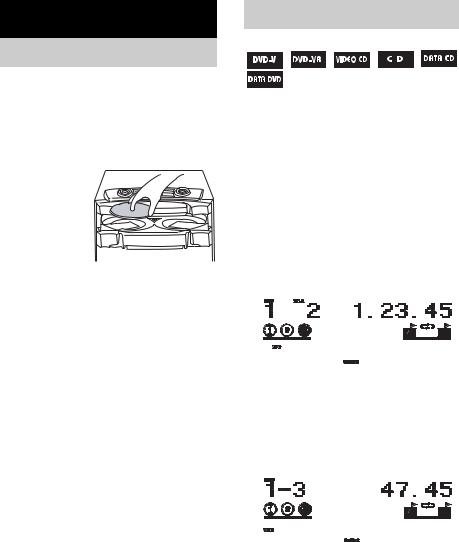
Disc – Playback
Playing a disc
Loading a disc
— Normal Play
Use the buttons on the unit for the operation.
1 Press Z OPEN/CLOSE.
The disc tray slides out.
2 Load a disc with the label side facing up on the disc tray.
When you play back an 8 cm
disc such as a  CD single, place
CD single, place 
it on the inner circle of the tray
To load additional discs, press EX-CHANGE/DISC SKIP to rotate the disc tray.
3 Press Z OPEN/CLOSE to close the disc tray.
Notes
•Do not forcibly push the disc tray to close it as this may cause a malfunction. Press Z OPEN/CLOSE to close the disc tray.
•When you eject a disc, handle the disc by its edge. Do not touch the surface of the disc.
Before playing a DVD VIDEO, a VIDEO CD, a CD Graphics*, JPEG image files or DivX video files, turn on your TV and select the video input. Depending on the DVD VIDEO or VIDEO CD, some operations may be different or restricted.
Refer to the operating instructions supplied with the disc.
* Latin American models only.
When playing a DVD VIDEO or DVD-R/ DVD-RW in VR mode:
Disc tray |
Elapsed |
|||||||||||||
number Title number |
playing time |
|||||||||||||
|
|
|
|
|
|
|
|
|
|
|
|
|
|
|
|
|
|
|
|
|
|
|
|
|
|
|
|
|
|
|
|
|
|
|
|
|
|
|
|
|
|
|
|
|
|
|
|
|
|
|
|
|
|
|
|
|
|
|
|
|
|
|
|
|
|
|
|
|
|
|
|
|
|
|
|
|
|
|
|
|
|
|
|
|
|
|
|
|
|
|
|
|
|
|
|
|
|
|
|
|
|
|
|
|
Disc playing Disc presence indicator indicator
When playing a VIDEO CD (playback without PBC function):
Disc tray |
Elapsed |
|||||||||||||
number Track number |
playing time |
|||||||||||||
|
|
|
|
|
|
|
|
|
|
|
|
|
|
|
|
|
|
|
|
|
|
|
|
|
|
|
|
|
|
|
|
|
|
|
|
|
|
|
|
|
|
|
|
|
|
|
|
|
|
|
|
|
|
|
|
|
|
|
|
|
|
|
|
|
|
|
|
|
|
|
|
|
|
|
|
|
|
|
|
|
|
|
|
|
|
|
|
|
|
Disc playing Disc presence indicator indicator
18GB
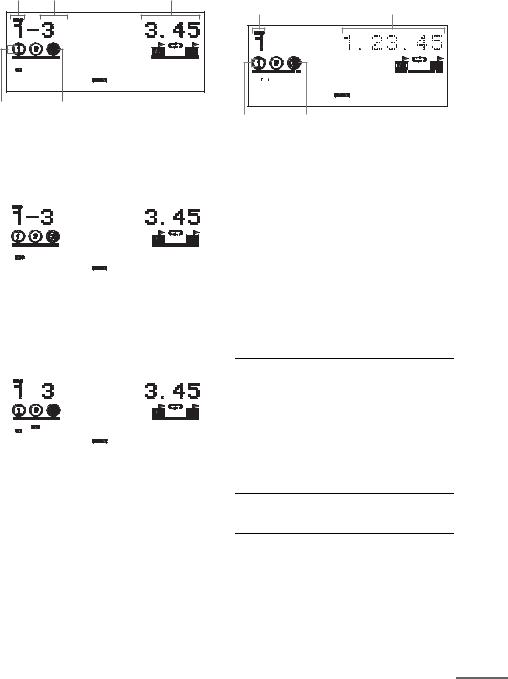
When playing an AUDIO CD:
Disc tray |
Elapsed |
number Track number |
playing time |
When playing a DivX video file (on a DATA DVD):
Disc tray |
Elapsed |
|
number |
playing time |
|
|
|
|
Disc playing Disc presence indicator indicator
When playing a CD Graphics (Latin American models only):
Disc tray |
Elapsed |
|||||||||||||
number Track number |
playing time |
|||||||||||||
|
|
|
|
|
|
|
|
|
|
|
|
|
|
|
|
|
|
|
|
|
|
|
|
|
|
|
|
|
|
|
|
|
|
|
|
|
|
|
|
|
|
|
|
|
|
|
|
|
|
|
|
|
|
|
|
|
|
|
|
|
|
|
|
|
|
|
|
|
|
|
|
|
|
|
|
|
|
|
|
|
|
|
|
|
|
|
|
|
|
|
|
|
|
|
|
|
|
|
|
|
|
|
|
|
Disc playing Disc presence indicator indicator
When playing an MP3 audio track:
Disc tray |
Track |
Elapsed |
||||||||||
number |
number |
playing time |
||||||||||
|
|
|
|
|
|
|
|
|
|
|
|
|
|
|
|
|
|
|
|
|
|
|
|
|
|
|
|
|
|
|
|
|
|
|
|
|
|
|
|
|
|
|
|
|
|
|
|
|
|
|
|
|
|
|
|
|
|
|
|
|
|
|
|
|
|
|
|
|
|
|
|
|
|
|
|
|
|
|
|
|
|
|
|
|
|
|
|
|
|
|
Disc playing |
Disc presence |
indicator |
indicator |
|
|
– Disc |
Disc playing |
Disc presence |
Playback |
|
||
indicator |
indicator |
|
1 Press FUNCTION +/– repeatedly to select “DVD” (or press DVD on the unit).
2 Press H (or nN on the unit).
3 Press VOLUME +/– (or turn MASTER VOLUME on the unit) to adjust the volume.
The volume level appears on the TV screen.
Note
Depending on the system status, the volume level may not appear on the TV screen.
Other operations
To |
Do this |
Stop playback |
Press x. |
|
|
Pause playback |
Press X. Press X again or H (or |
|
nN on the unit) to resume |
|
playback. |
|
|
Select a track1), |
Press . or > repeatedly |
chapter or video |
during playback. |
file |
Or, press the numeric buttons |
|
when the Control Menu is turned |
|
off, then press ENTER2). |
Select an album3) Press ALBUM +/– repeatedly during playback or when playback is paused.
continued
19GB
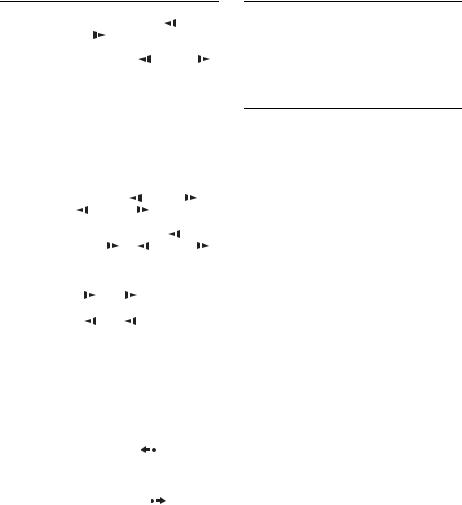
To |
Do this |
|
|
|
|
|
Locate a point |
Press m or M (or |
m or |
||||
quickly in fast |
M on the unit) during |
|
||||
forward or fast |
playback. Each time you press |
|
||||
reverse (Lock |
m or M (or m or M |
|
||||
Search)4)5) |
on the unit), the playback speed |
|||||
|
changes cyclically as follows: |
|
||||
|
Playback direction6) |
|
|
|||
|
x2B7) t 1M t 2M t |
|
||||
|
3M8) |
|
|
|
|
|
|
Opposite direction6) |
|
|
|||
|
x2b9) t 1m t 2m t |
|
||||
|
3m8) |
|
|
|
|
|
|
To return to normal playback, |
|
||||
|
press H (or nN on the unit). |
|||||
|
|
|
|
|||
Watch frame by |
Press SLOW |
or SLOW |
(or |
|||
frame (Slow- |
|
m or M on the unit) |
|
|||
motion Play)8) |
when playback is paused. Each |
|||||
|
time you press SLOW |
or |
|
|||
|
SLOW |
(or |
m or M |
|
||
|
on the unit), the playback speed |
|||||
|
changes as follows: |
|
|
|||
|
Playback direction10) |
|
|
|||
|
2 |
y 1 |
|
|
|
|
|
Opposite direction10)11) |
|
||||
|
2 |
y 1 |
|
|
|
|
|
To return to normal playback, |
|
||||
|
press H (or nN on the unit). |
|||||
|
|
|||||
Play one frame at |
Press STEP C to go to the next |
|||||
a time (Freeze |
frame when playback is paused. |
|||||
Frame)8) |
Press c STEP11) to go to the |
|||||
|
preceding frame when playback is |
|||||
|
paused. |
|
|
|
|
|
|
To return to normal playback, |
|
||||
|
press H (or nN on the unit). |
|||||
|
|
|
|
|||
Replay the |
Press REPLAY |
during |
|
|||
previous scene |
playback. |
|
|
|
|
|
(Instant |
|
|
|
|
|
|
Replay)11) |
|
|
|
|
|
|
Briefly fast |
Press ADVANCE |
during |
|
|||
forward the |
playback. |
|
|
|
|
|
current scene |
|
|
|
|
|
|
(Instant |
|
|
|
|
|
|
Advance)11) |
|
|
|
|
|
|
Select a disc |
Press DISC SKIP on the remote |
|||||
during playback |
(or one of the DISC 1 ~ 3 buttons |
|||||
or when playback |
on the unit). |
|
|
|
||
is stopped |
|
|
|
|
|
|
|
|
|
||||
Switch to DVD |
Press one of the DISC 1 ~ 3 |
|
||||
function from |
buttons on the unit (Automatic |
|
||||
another source |
Source Selection). |
|
|
|||
and start |
|
|
|
|
|
|
playback |
|
|
|
|
|
|
automatically |
|
|
|
|
|
|
|
|
|
|
|
|
|
To |
Do this |
Exchange other |
Press EX-CHANGE/DISC SKIP |
discs after the |
on the unit. |
disc’s TOC |
|
reading is |
|
complete |
|
|
|
Remove the disc |
Press Z OPEN/CLOSE on the |
|
unit. |
1)You cannot select an audio track during Lock Search operation of MP3 audio tracks.
2)DVD VIDEO, DVD-R/DVD-RW in VR mode, VIDEO CD, AUDIO CD, CD Graphics (Latin American models only) and DivX video files only.
3)MP3 audio tracks, JPEG image files and DivX video files only.
4)Except for JPEG image files and CD Graphics (Latin American models only).
5)Depending on the disc, the actual speed may differ.
6)The “x2B”/“x2b” playback speed is about twice the normal speed. The “3M”/“3m” playback speed is faster than “2M”/“2m” and the “2M”/“2m” playback speed is faster than “1M”/“1m”.
7)DVD VIDEO and AUDIO CD only.
8)DVD VIDEO, DVD-R/DVD-RW in VR mode, DivX video files and VIDEO CD only.
9)DVD VIDEO only.
10)The “2  ”/“2
”/“2  ” playback speed is slower than “1
” playback speed is slower than “1  ”/“1
”/“1  ”.
”.
11)DVD VIDEO and DVD-R/DVD-RW in VR mode only.
Notes
•You cannot search for a still picture on a DVD-R/ DVD-RW in VR mode.
•You cannot perform Instant Replay and Instant Advance in Repeat Play mode.
•(Latin American models only)
When playing CD Graphics, the picture may not appear smoothly.
Tips
•The Instant Replay function is useful when you want to review a scene or dialogue that you missed.
•The Instant Advance function is useful when you want to pass over a scene that you do not want to watch.
•You may not be able to use the Instant Replay or Instant Advance function with some scenes.
•If you press DVD on the unit while the system is turned off, the system turns on automatically and “DVD” is selected as the function except during Power Saving Mode.
20GB

Resuming playback from the point you stopped the disc
— Resume Play
This system memorizes the point where you stopped the disc so you can resume playback from that point. Resume Play is not canceled when you turn off the system except for MP3 audio tracks, JPEG image files and DivX video files.
1 While playing a disc, press x to stop playback.
“Resume” appears in the display. If “Resume” does not appear, Resume Play is not available.
2 Press H (or nN on the unit).
The system starts playback from the point you stopped the disc in step 1.
Notes
•You cannot perform Resume Play during Shuffle Play or Program Play.
•This function may not work properly with some discs.
•Depending on where you stopped the disc, the system may not resume playback from the exact same point.
•Resume Play is canceled when you
–press x when playback is stopped.
–open the disc tray.
–change the function.
–change the settings in the Control Menu.
•If “MULTI-DISC RESUME” is set to “ON”, Resume Play is not canceled for DVD VIDEO and VIDEO CD when you open the disc tray or change the function.
•(Latin American models only)
When using the Resume Play function on CD Graphics, playback starts from the beginning of the track.
Tip
To play back from the beginning of the disc, press x twice, then press H (or nN on the unit).
Resuming playback of the |
|
|||||||
disc that has been played |
|
|||||||
back |
|
|||||||
|
||||||||
— Multi-disc Resume |
|
|||||||
– Disc |
||||||||
|
|
|
|
|
|
|
||
|
|
|
|
|
|
|
||
|
|
|
|
|
|
|
||
|
|
|
|
|
|
|
||
same disc again. If you store a playback resume |
||||||||
Playback |
||||||||
This system can store the point where you |
|
|||||||
stopped the playback of the disc for up to 40 |
|
|||||||
discs and resumes playback when you insert the |
|
|||||||
point for the 41st disc, the playback resume |
|
|||||||
point for the first disc will be deleted. |
|
|||||||
To activate this function, set “MULTI-DISC |
|
|||||||
RESUME” in “CUSTOM SETUP” to “ON”. |
|
|||||||
For details, see “MULTI-DISC RESUME” on |
|
|||||||
page 47. |
|
|||||||
Note
If “MULTI-DISC RESUME” is set to “ON”, the system may play back the next recorded disc such as a DVD-RW from the playback resume point for the current recorded disc. To start playback from the beginning of the disc, press x twice and then press H (or nN on the unit).
Creating your own program
— Program Play
You can make a program of up to 99 steps in the order you want them to be played back.
You can only program the tracks from the current disc.
1 Press  DISPLAY.
DISPLAY.
The Control Menu appears on the TV screen.
continued
21GB
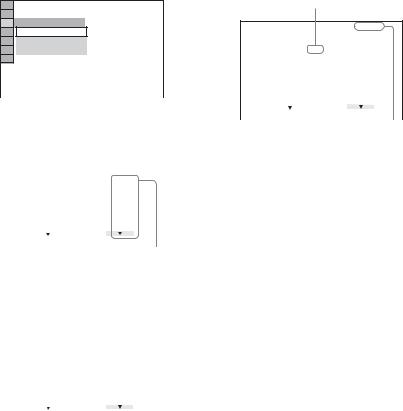
2 Press V or v repeatedly to select
 (PROGRAM), then press ENTER.
(PROGRAM), then press ENTER.
The options for “PROGRAM” appear on the TV screen.
|
6 ( 14) |
|
PLAY |
|
|
T |
2 : 5 0 |
|
CD |
||
|
|
|
|
|
|
OFF
OFF
SET 
ON
3 Press V or v repeatedly to select “SETt”, then press ENTER.
|
|
PROGRAM |
|
|
0 : 00 : 00 |
|
|
|
|
|
|
|
T |
|
|
|
|
ALL CLEAR |
|
|
– – |
|
|
|
|
1. TRACK |
– – |
|
|
|
|
|
|
2. TRACK |
– – |
|
01 |
|
|
|
|
3. TRACK |
– – |
|
02 |
|
|
|
|
4. TRACK |
– – |
|
03 |
|
|
|
|
5. TRACK |
– – |
|
04 |
|
|
|
|
6. TRACK |
– – |
|
05 |
|
|
|
|
7. TRACK |
– – |
|
06 |
|
|
|
|
|
|
|
|
|
|
|
|
|
|
|
Tracks number |
||
4 Press b. |
|
|
|
|
|
||
The cursor moves to the track row “T” (in this case, “01”).
|
PROGRAM |
|
0 : 00 : 00 |
||
|
|
|
|
T |
|
|
ALL CLEAR |
|
|
– – |
|
|
1. TRACK |
– – |
|
|
|
|
2. TRACK |
– – |
|
01 |
|
|
3. TRACK |
– – |
|
02 |
|
|
4. TRACK |
– – |
|
03 |
|
|
5. TRACK |
– – |
|
04 |
|
|
6. TRACK |
– – |
|
05 |
|
|
7. TRACK |
– – |
|
06 |
|
|
|
|
|
|
|
5 Select the track you want to program.
For example, select track “02”.
Press V or v repeatedly to select “02” under “T”, then press ENTER.
Selected track
PROGRAM |
|
0:15:30 |
||
|
|
|
T |
|
ALL CLEAR |
|
|||
|
|
|
|
|
|
|
– – |
|
|
1. TRACK |
0 2 |
|
|
|
2. TRACK |
– – |
|
01 |
|
3. TRACK |
– – |
|
02 |
|
4. TRACK |
– – |
|
03 |
|
5. TRACK |
– – |
|
04 |
|
6. TRACK |
– – |
|
05 |
|
7. TRACK |
– – |
|
06 |
|
Total time of the programmed tracks
6 To program other tracks, repeat steps
4 to 5.
7 Press H (or nN on the unit).
Program Play starts.
When the Program Play ends, you can restart the same program by pressing H (or nN on the unit).
To cancel Program Play
Press CLEAR or select “OFF” in step 3. To play back the same program again, select “ON” in step 3 and press ENTER.
To change a programmed step
1Follow steps 1 to 3 of “Creating your own program”.
2Press V or v repeatedly to select the
programmed step number you want to change. Then, press b.
3Follow step 5 of “Creating your own program” to program a new track.
To delete a programmed step
1Follow steps 1 to 3 of “Creating your own program”.
2Press V or v repeatedly to select the programmed step number you want to delete. Then, press CLEAR.
The selected step is deleted. The following steps are shifted up.
22GB
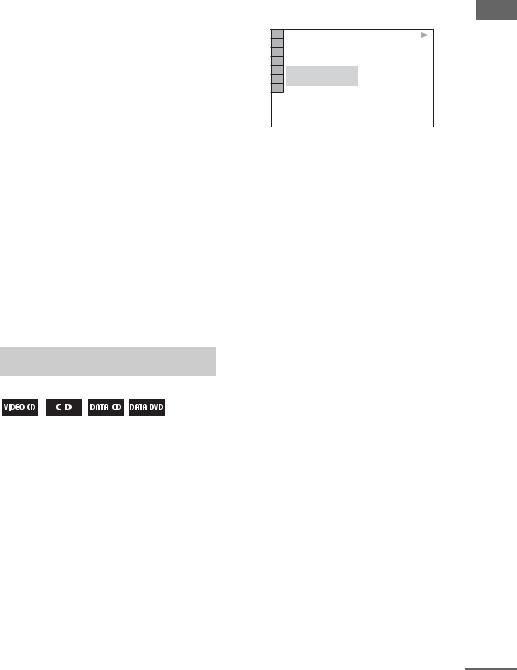
To delete all of the programmed steps in the program list
1Follow steps 1 to 3 of “Creating your own program”.
2Press V to select “ALL CLEAR”.
3Press ENTER.
To turn off the Control Menu
Press  DISPLAY repeatedly until the Control Menu disappears from the TV screen.
DISPLAY repeatedly until the Control Menu disappears from the TV screen.
Notes
•When Program Play is activated, the “REPEAT” setting is automatically changed to “ON” if the current setting is “ALL DISCS”, “ONE DISC” or “TRACK”.
•You cannot perform Program Play with VIDEO CDs during PBC playback.
Tip
The Program Play is canceled and the program list is cleared when
–you open the disc tray.
–you press DISC SKIP (or one of the DISC 1 ~ 3 buttons on the unit) to select another disc.
–you turn off the system.
–you change the function.
–you perform CD Synchro Recording.
Playing in random order
— Shuffle Play
You can play back the tracks on the current disc in random order. Each time you perform Shuffle Play, the playing order may differs.
1 Press  DISPLAY during playback.
DISPLAY during playback.
The Control Menu appears on the TV screen.
2 Press V or v repeatedly to select
 (SHUFFLE), then press ENTER.
(SHUFFLE), then press ENTER.
The options for “SHUFFLE” appear on the TV screen.
|
6 (14) |
|
|
PLAY |
|
|
T |
2 : 5 0 |
|
|
CD |
|
|
|
|||
|
|
|
|
|
|
|
OFF |
|
|
|
|
|
OFF |
|
|
|
|
TRACK
3 Press V or v repeatedly to select the setting you want.
xWhen playing a VIDEO CD or AUDIO CD
•TRACK: all tracks on the current disc is played back randomly.
xWhen Program Play is activated (see “Creating your own program” on page 21)
•ON: all tracks in the program list is played back randomly.
xWhen playing a DATA CD (except for DivX video files) or DATA DVD (except for DivX video files)
•ON: all MP3 audio tracks in the selected album on the current disc is played back randomly.
When no album is selected, the first album is played back randomly.
4 Press ENTER
Shuffle Play starts.
“SHUF” lights up in the display.
To cancel Shuffle Play
Press CLEAR or select “OFF” in step 3.
To turn off the Control Menu
Press  DISPLAY repeatedly until the Control Menu disappears from the TV screen.
DISPLAY repeatedly until the Control Menu disappears from the TV screen.
Playback – Disc
continued
23GB
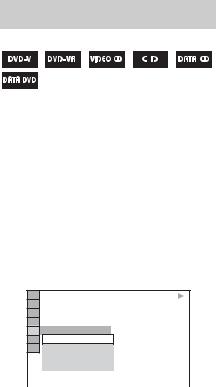
Notes
•Shuffle Play is only available for the tracks on the current disc.
•You cannot perform Shuffle Play with VIDEO CDs during PBC playback.
•Shuffle Play is canceled when
–you open the disc tray.
–you press DISC SKIP (or one of the DISC 1 ~ 3 buttons on the unit) to select other disc.
–you turn off the system.
–you change the function.
–you perform Track/Index Search.
–you perform CD Synchro Recording.
•The same song may be played back repeatedly for MP3 audio tracks.
Tip
You can also change the Shuffle Play setting when playback is stopped.
Playing repeatedly
— Repeat Play
You can play back all the titles, tracks, files or a single title, chapter, track or file on a disc repeatedly.
You can select Shuffle Play and Program Play at the same time.
1 Press  DISPLAY during playback.
DISPLAY during playback.
The Control Menu appears on the TV screen.
2 Press V or v repeatedly to select
 (REPEAT), then press ENTER.
(REPEAT), then press ENTER.
The options for “REPEAT” appear on the TV screen.
|
6 (14) |
|
PLAY |
T |
2 : 5 0 |
|
CD |
|
|
OFF
OFF
ALL DISCS
ONE DISC
TRACK
3 Press V or v repeatedly to select the setting you want.
The default settings are underlined.
xWhen playing a DVD VIDEO or DVD-R/DVD-RW in VR mode
•OFF: does not play back repeatedly.
•ALL DISCS: repeats all the titles on all the discs.
•ONE DISC: repeats all the titles on the current disc.
•TITLE: repeats the current title.
•CHAPTER: repeats the current chapter.
xWhen playing a VIDEO CD or AUDIO CD
•OFF: does not play back repeatedly.
•ALL DISCS: repeats all the tracks on all the discs.
•ONE DISC: repeats all the tracks on the current disc.
•TRACK: repeats the current track.
xWhen playing a DATA CD or DATA DVD
•OFF: does not play back repeatedly.
•ALL DISCS: repeats all the tracks or files on all the discs.
•ONE DISC: repeats all the albums on the current disc.
•ALBUM: repeats the current album.
•TRACK1): repeats the current track.
•FILE2): repeats the current file.
xWhen Program Play or Shuffle Play is activated
•OFF: does not play back repeatedly.
•ON: repeats the Program Play or Shuffle Play.
4 Press ENTER.
Repeat Play starts.
1)MP3 audio tracks only.
2)DivX video files only.
To cancel Repeat Play
Press CLEAR or select “OFF” in step 3.
To turn off the Control Menu
Press  DISPLAY repeatedly until the Control Menu disappears from the TV screen.
DISPLAY repeatedly until the Control Menu disappears from the TV screen.
24GB
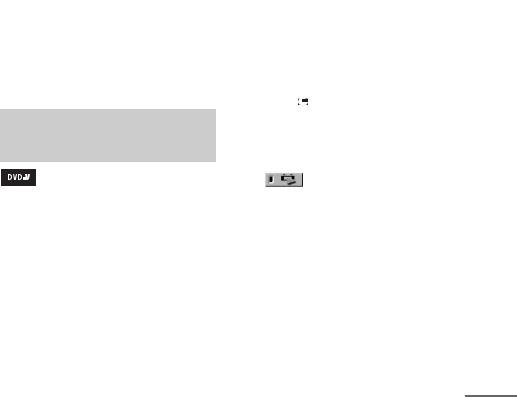
Notes
•You can also change the Repeat Play setting by pressing REPEAT repeatedly.
•“REPEAT” lights up in the display when Repeat Play is set to “ALL DISCS”, “ONE DISC”, “ALBUM” or “ON”.
•“REPEAT1” lights up in the display when Repeat Play is set to “TITLE”, “CHAPTER”, “TRACK” or “FILE”.
•Depending on the DVD VIDEO, you cannot perform Repeat Play.
•You cannot perform Repeat Play with VIDEO CDs during PBC playback.
•When playing a DATA CD or DATA DVD which contains MP3 audio tracks and JPEG image files, the audio sound will not match the image if their playing time are different.
•You cannot select “TRACK” when “MODE (MP3, JPEG)” is set to “IMAGE (JPEG)”.
•Repeat Play is canceled when
–you open the disc tray.
–you press DISC SKIP (or one of the DISC 1 ~ 3 buttons on the unit) to select other disc (unless Repeat Play is set to “ALL DISCS”).
–you turn off the system
–you change the function (unless Repeat Play is set to “ALL DISCS”).
–you perform CD Synchro Recording.
Tip
You can also change the Repeat Play setting when playback is stopped.
Playing DVD VIDEOs using the menu
Some DVD VIDEOs have menus to help you enjoy the DVD VIDEOs. You can play back DVD VIDEOs using these menus on the TV screen.
Using TOP MENU
A DVD VIDEO contains a lot of sections of picture or music feature called “title”. When you play back a DVD VIDEO which contains several titles, you can select the title you want using TOP MENU.
Using MENU
Some DVD VIDEOs allow you to select the disc |
|
||||||||||
contents using a menu. When you play back |
|
||||||||||
these DVD VIDEOs, you can select items such |
|
||||||||||
|
|||||||||||
as the language for the subtitles and the language |
|
||||||||||
Disc |
|||||||||||
for the sound using MENU. |
|
|
|
|
|||||||
1 Press TOP MENU or MENU. |
– |
||||||||||
The menu appears on the TV screen. The |
|||||||||||
Playback |
|||||||||||
contents of the menu vary depending on the |
|||||||||||
|
|||||||||||
disc. |
|
|
|
|
|
|
|
||||
2 Press V and v or B and b or the |
|
||||||||||
numeric buttons to select the title or |
|
||||||||||
item you want to play back. |
|
||||||||||
3 Press ENTER. |
|
|
|
|
|
||||||
|
|
|
|
|
|
|
|
||||
Selecting “ORIGINAL” or |
|
|
|||||||||
“PLAY LIST” on a DVD-R/ |
|
|
|||||||||
DVD-RW in VR mode |
|
|
|||||||||
|
|
|
|
|
|
|
|
||||
|
|
|
|
|
|
|
|
||||
You can play back DVD-Rs/DVD-RWs in VR |
|
||||||||||
mode either according to the originally recorded |
|
||||||||||
sequence or to the playlist created on the disc. |
|
||||||||||
This function is only available for DVD-Rs/ |
|
||||||||||
DVD-RWs in VR mode with a playlist created. |
|
||||||||||
1 Press |
DISPLAY when playback is |
|
|||||||||
stopped. |
|
|
|
|
|
||||||
The Control Menu appears on the TV |
|
||||||||||
screen. |
|
|
|
|
|
|
|
||||
2 Press V or v repeatedly to select |
|
||||||||||
|
|
|
|
(ORIGINAL/PLAY LIST), then |
|
||||||
press ENTER. |
|
|
|
|
|
||||||
The options for “ORIGINAL/PLAY LIST” |
|
||||||||||
appear on the TV screen. |
|
|
|
|
|
||||||
|
|
|
|
|
|
|
|
|
|
|
|
|
|
|
1 |
( 4 4 ) |
|
|
|
|
|
|
|
|
|
|
3 |
( 2 8 ) |
|
DVD-VR |
|
|
|
||
|
|
|
T |
1 : 3 0 : 5 0 |
|
|
|
|
|
|
|
|
|
|
PLAY LIST |
|
|
|
|
|
|
||
|
|
|
PLAY LIST |
|
|
|
|
|
|
||
|
|
|
ORIGINAL |
|
|
|
|
|
|
||
|
|
|
|
|
|
|
|
|
|
|
|
|
|
|
|
|
|
|
|
|
|
|
|
|
|
|
|
|
|
|
|
|
|
|
|
continued
25GB
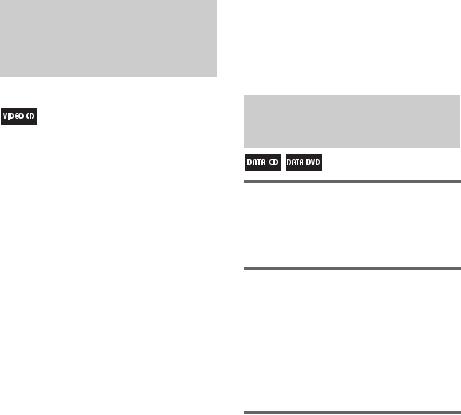
3 Press V or v repeatedly to select the setting you want.
•PLAY LIST: play back according to the playlist created on the disc.
•ORIGINAL: play back according to the originally recorded sequence.
4 Press ENTER.
Playing VIDEO CDs with PBC functions (Version 2.0)
— PBC Playback
You can use the PBC (Playback Control) menus on your TV screen to enjoy the disc’s interactive software. The menu format and structure may differ depending on each disc.
1 Press H (or nN on the unit) to start playing a VIDEO CD with PBC functions (Version 2.0).
The PBC menu appears on the TV screen.
2 Press the numeric buttons to select the item number you want.
3 Press ENTER.
4 Continue playback according to the instructions on the menus to enjoy interactive playback.
Refer to the operating instructions supplied with the VIDEO CD, as the operating procedure may differ depending on the VIDEO CD.
To return to the previous menu
Press O RETURN.
Notes
•Depending on the VIDEO CD, the menu may not appear in step 1.
•Depending on the VIDEO CD, “Press ENTER” in step 3 may appear as “Press SELECT” in the operating instructions supplied with the disc. In this case, press H (or nN on the unit).
•PBC Playback is canceled when Shuffle Play, Program Play or Repeat Play is activated.
To cancel playback with PBC functions
1Press . or > repeatedly or press the numeric buttons to select a track when playback is stopped.
2Press H (or nN on the unit) or ENTER.
“Play without PBC.” appears on the TV screen and playback starts from the selected track. Still images, such as the menu screens, will not be shown.
To return to PBC playback, press x twice, then press H (or nN on the unit).
About MP3 audio tracks and JPEG image files
What is MP3/JPEG?
MP3 is an audio compression technology that satisfies the ISO/MPEG regulations. JPEG is an image compression technology.
Discs that the system can play back
For details on DATA CDs (CD-ROMs/CD-Rs/ CD-RWs) or DATA DVDs (DVD-ROMs/ DVD-Rs/DVD-RWs/DVD+Rs/DVD+RWs) that the system can play back, see “Notes on discs” (page 6) and “Notes on Multi Session disc” (page 8).
MP3 audio tracks or JPEG image files that the system can play back
The system can play back MP3 audio tracks which have the extension “.MP3” and JPEG image files which have the extension “.JPG” or “.JPEG”.
26GB
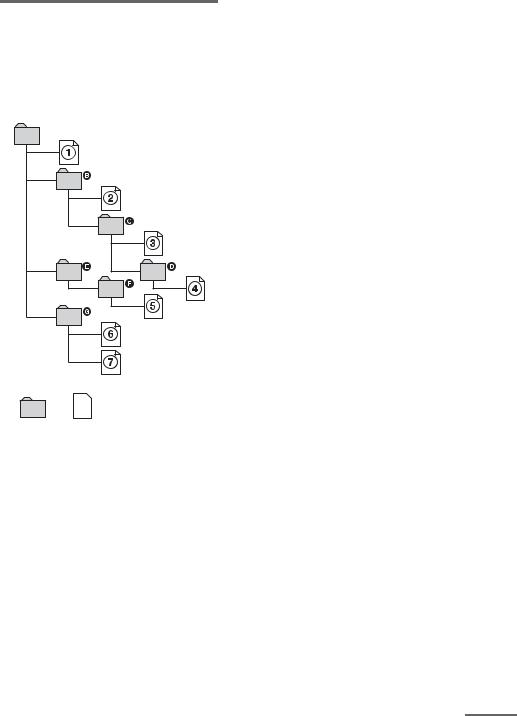
Playback order of MP3 audio tracks or JPEG image files
The playback order of MP3 audio tracks or JPEG image files recorded on a DATA CD or DATA DVD is as follows:
x Structure of disc contents
Tree 1 Tree 2 |
Tree 3 Tree 4 Tree 5 |
ROOT 
Album |
|
|
|
|
|
|
|
MP3 audio tracks or |
|||
|
JPEG image files |
||
|
|
|
|
When you insert a DATA CD or DATA DVD and press H (or nN on the unit), the tracks (or files) are played back sequentially, from 1 through 7. Any sub-albums or sub-files in the selected album take priority over the next album in the same tree. (Example: Ccontains Dso 4 is played back before 5.)
When you press MENU and the list of album names appears (page 29), the album names are arranged in the following order:
A t B t C t D t F t G. Albums that do not contain tracks (or files) (such as album E) do not appear in the list.
Notes
•Depending on the software you use to create the DATA CD or DATA DVD, the playback order may differ from the illustration above.
• The playback order above may not be applicable if |
|
|
there are more than 200 albums and 300 files in each |
|
|
Disc |
||
• The system can recognize up to 200 albums |
||
album. |
|
|
including albums that do not contain MP3 audio |
– |
|
Playback |
||
image files on an album which this system can |
||
tracks and JPEG image files. The system will not |
|
|
play back any albums beyond the 200th album. |
|
|
• The maximum number of MP3 audio tracks or JPEG |
|
|
recognize is: |
|
|
– 600 when “MODE (MP3, JPEG)” is set to |
|
|
“AUDIO (MP3)” or “IMAGE (JPEG)”. |
|
|
– 300 when “MODE (MP3, JPEG)” is set to |
|
|
“AUTO”. |
|
|
• The system may take a longer time to start playback, |
|
|
when the tracks or files in another album has just |
|
|
been played back. |
|
|
• An album that does not contain an MP3 audio track |
|
|
or JPEG image file is skipped. |
|
|
• The system will play back any data with the |
|
|
extension “.MP3”, “.JPG” or “.JPEG” even if they |
|
|
are not in MP3 or JPEG format. Playing this data |
|
|
may generate a loud noise which could damage your |
|
|
speaker system. |
|
|
• The system does not support MP3PRO format. |
|
|
• The system can only play back MP3 audio tracks in |
|
|
MPEG 1 Audio Layer 3 format. |
|
|
• Depending on the encoding/writing software, |
|
|
recording device, or the recording media used to |
|
|
record an MP3 audio track, you may encounter |
|
|
problems such as cannot play back, sound |
|
|
interruptions and noise. |
|
|
• The following discs take a longer time to start |
|
|
playback: |
|
|
– a disc recorded with complicated tree structure. |
|
|
– a disc recorded in Multi Session. |
|
|
– a disc to which data can be added (non finalized |
|
|
disc). |
|
|
• Some CD-Rs/CD-RWs/DVD-Rs/DVD-RWs/ |
|
|
DVD+Rs/DVD+RWs cannot be played back on the |
|
|
system depending on the file format. |
|
continued
27GB
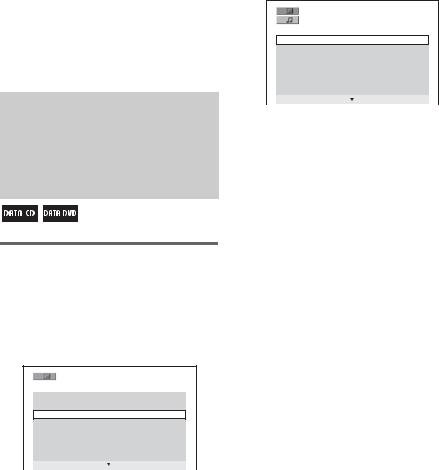
•When playing a DATA CD (CD-ROMs/CD-Rs/ CD-RWs) or DATA DVD (DVD-ROMs/DVD-Rs/ DVD-RWs/DVD+Rs/DVD+RWs) containing both MP3 audio tracks and JPEG image files, select “MODE (MP3, JPEG)” from the Control Menu after the disc’s TOC reading is complete. If you want to play back
–both MP3 audio tracks and JPEG image files, set “MODE (MP3, JPEG)” to “AUTO”.
–MP3 audio tracks only, set “MODE (MP3, JPEG)” to “AUDIO (MP3)”.
–JPEG image files only, set “MODE (MP3, JPEG)” to “IMAGE (JPEG)”.
•The system can play back to a depth of 8 folders only.
Tips
•If you add numbers (01, 02, 03, etc.) to the front of the track or file names when you store the tracks or files in a disc, the tracks and files will be played back in that order.
•Since a disc with many trees takes a longer time to start playback, it is recommended that you create albums with no more than two trees.
Playing DATA CDs or DATA DVDs with MP3 audio tracks and JPEG image files
Playing an album of MP3 audio tracks or an MP3 audio track
1 Load a DATA CD or DATA DVD on the disc tray.
The list of albums appears on the TV
screen. |
3 ( 3 0 ) |
R O C K B E S T H I T |
K A R A O K E |
M Y F A V O U R I T E S O N G |
R & B |
J A Z Z |
C L A S S I C |
S A L S A O F C U B A |
B O S S A N O V A |
2 Do the following steps to play back an album of MP3 audio tracks or an MP3 audio track.
x Playing an album of MP3 audio tracks
Press V or v repeatedly to select the album you want, then press H (or nN on the unit).
The system starts playback from the first track of the selected album.
x Playing an MP3 audio track
1Press V or v repeatedly to select the album you want, then press ENTER.
The list of MP3 audio tracks of the selected album appears on the TV screen.
M Y F A V O U R I T E S O N G |
|
1 ( 2 5 6 ) |
|
W A L T Z F O R D E B B Y |
|
M Y R O M A N C E |
|
M I L E S T O N E S |
|
M Y F U N N Y V A L E N T I N E |
|
A U T U M N L E A V E S |
|
A L L B L U E S |
|
S O M E D A Y M Y P R I N C E |
W... |
2Press V or v repeatedly to select the MP3 audio track you want, then press ENTER.
The system starts playing the selected MP3 audio track.
To stop playback
Press x.
To display the next or previous page of track list or album list
Press B or b repeatedly when the track list or album list is displayed.
To play back the next or previous MP3 audio track
Press . or > repeatedly during playback.
28GB
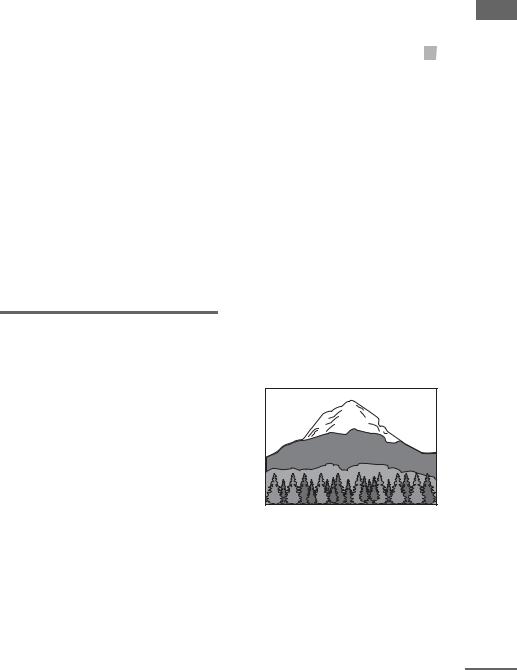
To play back the next album of MP3 audio tracks
You can select the next album by pressing > repeatedly until the last track of the current album, then press > once. The first track of the next album is selected. However, you cannot select the previous album by pressing . repeatedly. To select the previous album, select the album from the album list.
To return to the album list display when the track list is displayed
Press O RETURN.
To turn on or off the display of album list or track list
Press MENU repeatedly.
Notes
•You can view the disc information while playing MP3 audio tracks (page 73).
•You can select Repeat Play while playing MP3 audio tracks (page 24).
•You can press AUDIO to select the audio signal you want while playing an MP3 audio track (page 37).
Playing an album of JPEG image files or a JPEG image file
1 Load a DATA CD or DATA DVD on the disc tray.
The list of albums appears on the TV screen.
2 Do the following steps to play back an album of JPEG image files or a JPEG image file.
x Playing an album of JPEG image files
Press V or v repeatedly to select the album you want, then press H (or nN on the unit).
The system starts a slide show from the first image file of the selected album.
x Playing a JPEG image file
1Press V or v repeatedly to select the album you want, then press PICTURE NAVI.
Thumbnail picture for the first 16 JPEG image files in the selected album is displayed on the TV screen.
1 |
2 |
3 |
4 |
|
5 |
6 |
7 |
8 |
|
9 |
10 |
11 |
12 |
|
13 |
14 |
15 |
16 |
|
If there are more than 16 image files in the selected album, the scroll bar appears at the right. Press v repeatedly until the bottom row of the thumbnail picture. Then, press v.
The TV screen will show the thumbnail picture of the next 16 image files.
To return to the thumbnail picture of the previous 16 image files, press V repeatedly until
the top row of the thumbnail picture. Then, press
V.
2Press V/v/B/b to select the image you want to view, then press H (or nN on the unit).
The slide show starts from the selected image
file. |
To display the next or previous page of album list
Press B or b repeatedly when the album list is displayed.
To display the next or previous JPEG image file
Press B or b repeatedly during the slide show.
continued
Playback – Disc
29GB
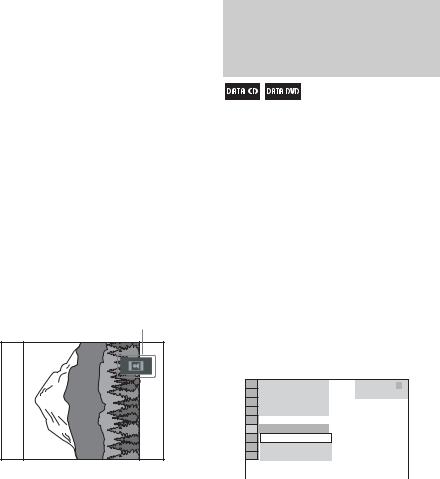
To play back the next album of JPEG image files
You can select the next album by pressing b repeatedly until the last file of the current album, then press b once. The first file of the next album is selected. However, you cannot select the previous album by pressing B repeatedly. To select the previous album, select the album from the album list.
To turn on or off the display of album list
Press MENU repeatedly.
To rotate a JPEG image file
When a JPEG image file is displayed on the TV screen, you can rotate the image by 90 degrees. Press V or v repeatedly while viewing an image. Each time you press V, the image rotates counterclockwise by 90 degrees.
Example: When you press V once
Rotating direction
Press CLEAR to return to the original view.
To stop playback
Press x.
Notes
•When you press B or b to select the next or previous image, the image will return to its original view even if you have rotated the image previously.
•The slide show stops when you press V or v.
•You can view the file information while playing JPEG image files (page 75).
•You can select Repeat Play while playing JPEG image files (page 24).
Tip
You can also change the slide show speed (page 31) and effect (page 32) while playing JPEG image files.
Playing MP3 audio tracks and JPEG image files as a slide show with sound
You can play back a slide show with sound by first placing both JPEG image files and MP3 audio tracks in the same album on a DATA CD or DATA DVD.
1 Load a DATA CD or DATA DVD on the disc tray.
The list of albums appears on the TV screen.
2 Press  DISPLAY.
DISPLAY.
The Control Menu appears on the TV screen.
3 Press V or v repeatedly to select
 (MODE (MP3, JPEG)), then press ENTER.
(MODE (MP3, JPEG)), then press ENTER.
The options for “MODE (MP3, JPEG)” appear on the TV screen.
( 2 7 )
DATA CD MP3
AUTO
AUTO
AUDIO (MP3)
IMAGE (JPEG)
The default setting is underlined.
•AUTO: play back both JPEG image files and MP3 audio tracks in the same album as a slide show with sound.
•AUDIO (MP3): play back MP3 audio tracks continuously.
•IMAGE (JPEG): play back JPEG image files as a slide show.
4 Press V or v repeatedly to select
“AUTO”, then press ENTER.
5 Press MENU.
The list of albums appears on the TV screen.
30GB
